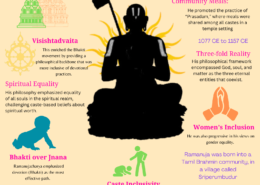Describe the beginnings and development of devotional Bhakti in South India and talk about the ways in which this popular movement found expression in the region’s vernacular literature.
Model Answer Introduction The Bhakti and Sufi movements were pivotal in transforming the nature of religion in medieval India, making it accessible to all, regardless of social status. Emerging between the 8th and 18th centuries, the Bhakti movement, rooted in devotion to God, and the Sufi movement,Read more
Model Answer
Introduction
The Bhakti and Sufi movements were pivotal in transforming the nature of religion in medieval India, making it accessible to all, regardless of social status. Emerging between the 8th and 18th centuries, the Bhakti movement, rooted in devotion to God, and the Sufi movement, focused on mystical experiences within Islam, both offered alternative spiritual paths that transcended the traditional boundaries of caste, class, and elite exclusivity.
Bhakti Movement
The Bhakti movement, which originated in South India, emphasized personal devotion and emotional connection with God. It rejected the complex and expensive Brahminical rituals that had previously restricted religious practice to the elite. Bhakti saints like Kabir, Tulsidas, and Tukaram encouraged devotion through simple acts of worship, including devotional songs and poems in regional languages, making religious practice accessible to people of all castes and social classes.
By focusing on love and service to God, Bhakti leaders emphasized an egalitarian approach, encouraging the participation of common people in spiritual life. Although the movement did not entirely challenge the caste system, it promoted an ideal of spiritual equality, allowing ordinary people to experience a direct relationship with God without intermediaries.
Sufi Movement
Similarly, the Sufi movement, which originated in Persia and spread to India, emphasized a personal, emotional connection with God. Sufi mystics, such as Moinuddin Chishti and Bulleh Shah, focused on love, compassion, and service, offering a more inclusive approach to spiritual practice. They used music, dance, and poetry, making their teachings accessible to a wide audience. The Sufis rejected rigid religious formalism and promoted a direct, heartfelt experience of God, making religion more open to people of all social strata.
The Sufi message of communal harmony and social service helped bridge divides between Hindus and Muslims, promoting religious tolerance and mutual respect.
Conclusion
In conclusion, both the Bhakti and Sufi movements played a transformative role in making religion more accessible to the common people by focusing on devotion, love, and direct experiences of God. While they had their limitations, particularly regarding caste and gender inequalities, their impact on India’s spiritual and social landscape was profound, breaking down the traditional hierarchies and making spirituality a shared experience for all.
See less

The Bhakti movement as it originated in South India in the eighth century refers to the religious movement during the medieval period, which propagated the concept of Bhakti i.e., intense love and devotion to God while condemning rituals, ceremonies and superstitions. It sought to bring religious reRead more
The Bhakti movement as it originated in South India in the eighth century refers to the religious movement during the medieval period, which propagated the concept of Bhakti i.e., intense love and devotion to God while condemning rituals, ceremonies and superstitions. It sought to bring religious reforms to all strata of society by adopting the method of devotion to achieve salvation. It achieved a great deal of popularity through the poems of the Alvars and Nayanars, the Vaishnavite and Shaivite poets.
Its origin and spread can be traced as following
Thus, the Bhakti movement spread in South India through various saints who denounced rigidities of Hinduism. The vernacular language of the south depicts the Bhakti movement in following form:
See less